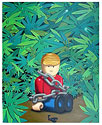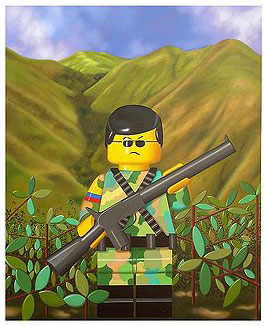Nadín Ospina
(b. Bogotá, Colombia 1960). In 1992, Ospina takes the Salón Nacional de Artistas Colombianos’ First Prize with In partibus infidelium [En tierras de infieles] --a proposal meant to radically alter the rhetoric of what lies at the core of Colombia’s national being-- by stage-mounting replicas of pre-Columbian ceramics, display windows, seeds, paintings, sounds and the scents of the palo santo –the aromatic guayaco tree. In this vein, over the 90’s, Ospina created a number of series employing appropriation as a critical tool in order to reveal the [operations/procedures/distortions] incurred by the museum and the cultural industries vis à vis pre-Columbian cultures and the culture of entertainment. Their recent archaeologies, such as the Simpsons transformed into archaic figures, or the casting of a pre-Hispanic sorcerer behind a Mickey mouse face, were a blending of past and present that jocularly reviewed power relations affecting consumption among the so-called "centers" and their "peripheries". These series, created during the heyday of multiculturalism, made ironic statements concerning the stereotypes of official cultural diversity which are fixed, packaged, commercialized and administered.
His recent traveling show, Colombia Land, has been presented so far at the Centro Cultural de la Universidad de Salamanca, Bogota (2004); at the Galería Mundo, Bogota (2005) and at the Instituto Cervantes, Paris (2007). He has participated in many collective shows in Europe and America. He was a part of the Sao Paulo, Brazil, Biennial (1989); the Havana Biennial (1994); the Mercosur Biennial, Portoalegre, Brazil (1999); the Lyon Biennial, France, and the Havana Biennial (2000); in the Venice Biennial and the Barro de América Biennial [American Clay Biennial] at the Museo Sofía Imber, Caracas, Venezuela (2001). His work is included in the Ludwig Forum collection in Germany; in the Rijksmuseum voor Volkenkunde, National Museum of Ethnology, Leiden, Holland; in the Daros-Latinamerica Collection in Zürich, Switzerland; in the Collection of Latin American Art at the University of Essex, Colchester, England; in the Art Gallery of Western Australia, Perth, Australia; in the Patchett Collection, Los Angeles, USA; in the Caracas Museum of Fine Arts, Venezuela; in the Bass Museum of Miami, Florida, and in all the most important museums of Colombia.
The interview from 2005 with Manuel Neves, which takes the Colombia Land exhibit at the Instituto Cervantes in Paris as a starting point, deals with the shifts in her production, his interest in the ambivalence of the toy, and the paradoxes entailed in dealing with violence within an artistic framework.
|







